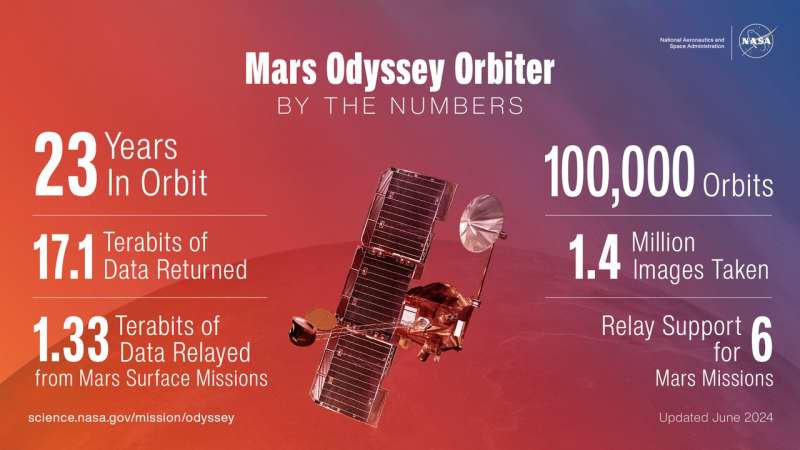
This infographic highlights the amount of data and number of images that NASA’s 2001 Mars Odyssey orbiter collected during its 23-year orbit around the Red Planet. Credit: NASA/JPL-Caltech
NASA’s longest-running Mars rover is set to hit another milestone on June 30: 100,000 trips around the Red Planet since its launch 23 years ago. Meanwhile, the 2001 Mars Odyssey orbiter mapped minerals and ice on the Martian surface, identifying landing sites for future missions and relaying data back to Earth from NASA’s rovers and landers.
Scientists recently used the orbiter’s camera to capture a stunning new image of Olympus Mons, the tallest volcano in the solar system. The image is part of an ongoing effort by the Odyssey team to provide high-altitude views of the planet’s horizon. (The first of these views was released in late 2023.) Similar to the perspective of Earth-based astronauts aboard the International Space Station, this view allows scientists to learn more about the clouds and dust suspended in the air on Mars.
Taken on March 11, the latest skyline image captures Olympus Mons in all its glory. With a base spanning 600 kilometers, the shield volcano rises to a height of 27 kilometers.

NASA’s Mars Odyssey 2001 orbiter captured this unique image of Olympus Mons, the solar system’s tallest volcano, on March 11, 2024. In addition to providing an unprecedented view of the volcano, the image helps scientists study different layers of material in the atmosphere, including clouds and dust. Credit: NASA/JPL-Caltech/ASU
“Usually we see Olympus Mons in narrow bands from the sky, but by turning the spacecraft toward the horizon, we can see in a single image how much it dominates the landscape,” said Jeffrey Plaut, Project Odyssey scientist at NASA’s Jet Propulsion Laboratory in Southern California, which manages the mission. “The image is not only spectacular, but it also provides us with unique scientific data. »
In addition to offering a freeze frame of clouds and dust, such images, taken over multiple seasons, can give scientists a more detailed understanding of the Martian atmosphere.
A blue-white band at the bottom of the atmosphere hints at the amount of dust present there in early fall, a time when dust storms typically begin to form. The purplish layer above was likely a mixture of red dust from the planet and bluish clouds of water ice. Finally, toward the top of the image, a blue-green layer is visible where the water ice clouds rise about 50 kilometers into the sky.
How they took the photo
Named after Arthur C. Clarke’s classic science fiction novel “2001: A Space Odyssey,” the orbiter captured the scene with a heat-sensitive camera called the Thermal Emission Imaging System, or THEMIS, that Arizona State University in Tempe built and operates. But because the camera is supposed to look at the surface, taking a picture of the horizon requires extra planning.
By firing thrusters located around the spacecraft, Odyssey can point THEMIS at different parts of the surface or even slowly turn around to observe Mars’ tiny moons, Phobos and Deimos.
The recent horizon imaging was conceived as an experiment many years ago during the landings of NASA’s Phoenix mission in 2008 and the Curiosity rover in 2012. As with other Mars landings before and after the he landing of these missions, Odyssey played an important role in relaying data as a spacecraft. rushed towards the surface.
To transmit their vital technical data to Earth, Odyssey’s antenna had to be aimed toward the newly arrived spacecraft and its landing ellipses. Scientists were intrigued when they noticed that the positioning of Odyssey’s antenna for this task meant that THEMIS would be pointed toward the planet’s horizon.
“We just decided to turn on the camera and see what it looked like,” said Odyssey space mission operations engineer Steve Sanders of Lockheed Martin Space in Denver. Lockheed Martin built Odyssey and helps run day-to-day operations alongside JPL mission leaders. “Based on these experiments, we designed a sequence that keeps THEMIS’s field of view centered on the horizon as we travel across the planet.”
The secret of a long space odyssey
What is Odyssey’s secret to being the longest continuously active mission in orbit around a planet other than Earth?
“The physics does a lot of the work for us,” Sanders said. “But these are the intricacies that we have to deal with again and again.”
These variables include fuel, solar energy and temperature. To ensure that Odyssey uses its fuel (hydrazine) sparingly, engineers must calculate how much is left, since the spacecraft does not have a fuel gauge. Odyssey relies on solar energy to operate its instruments and electronics. This energy varies as the spacecraft disappears behind Mars for about 15 minutes per orbit. And temperatures must remain balanced for all of Odyssey’s instruments to function properly.
“It takes careful oversight to ensure the continuity of such a long mission while respecting a historic timeline of science planning and execution, as well as innovative engineering practices,” said Odyssey Project Director Joseph Hunt of JPL. “We look forward to collecting more high-quality science data in the years to come.”
Quote: NASA’s Mars Odyssey orbiter captures huge volcano, near 100,000 orbits (June 27, 2024) retrieved June 28, 2024 from https://phys.org/news/2024-06-nasa-mars-odyssey- orbiter-captures.html
This document is subject to copyright. Apart from any fair dealing for the purpose of private study or research, no part may be reproduced without written permission. The content is provided for informational purposes only.